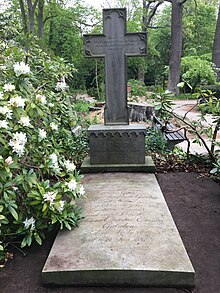Carl Philipp Gütschow


Carl Philipp Gütschow (born January 26, 1794 in Lübeck ; † November 13, 1838 ibid) was a German physician and the first doctor at the Lübeck insane asylum .
Life
Carl Philipp Gütschow was a son of the Lübeck Council Syndicate Anton Diedrich Gütschow and his wife Christine Margreth, born. Plessing, daughter of the Mayor of Lübeck Johann Philipp Plessing . He attended the Katharineum in Lübeck until Easter 1814. After a short time as a war volunteer in the Hanseatic Legion , Gütschow began studying medicine at the University of Kiel ; in April 1815 he moved to the University of Göttingen , where he was awarded a doctorate in 1817. med. received his doctorate. In 1815 he became a member of the Corps Hannovera Göttingen .
In 1819 he was appointed the first full-time family doctor in the Lübeck insane asylum , which was built in 1788 . From 1820 he was also the poor doctor for the Jakobi district in Lübeck . He fundamentally reformed the madhouse, made not only dangerousness but also the need for treatment the criterion for admission and introduced occupational therapy for the first time . Gütschow was a member of the Medical Association of Lübeck and the Society for the Promotion of Charitable Activities in Lübeck.
His successor was Georg Bernhard Eschenburg .
Gütschow was married to Johanna Helene geb. Kohpeis (1803-1870) and had three daughters and three sons with her. Else Gütschow and Margarethe Gütschow were his granddaughters.
Literary
The figure of Dr. Grabow in Thomas Mann's Buddenbrooks is based on Carl Philipp Gütschow.
Works
- Antiquioris scarlatinae febris historiae adumbratio. Goettingae: typis Friderici Ernesti Huth 1817 (Diss.)
literature
- Theodor Eschenburg (1853–1921): The Lübeck Medical Association during the first 100 years of its existence 1809–1909 , Wiesbaden 1909
- Friedrich von Rohden: The Medical Association of Lübeck: 150 Years of Medical History, 1809–1959 , Schmidt-Römhild, Lübeck 1959
- Friedrich von Rohden: From old Lübeck doctors in: Der Wagen 1960, pp. 83-100
- Bern Carrière (Ed.): The Medical Association of Lübeck: 175 years of its history, 1809–1984 , Verlag Ärzteverein, Lübeck 1984
- Rüdiger Kurowski: Medical lectures in the Lübeck Society for the Promotion of Charitable Activities 1789-1839: a patriotic society during the Enlightenment and Romanticism , Schmidt-Römhild, Lübeck 1995
- Antjekathrin Graßmann (Hrsg.): Madhouse and Sanatorium Strecknitz in: Lübeck-Lexikon . Schmidt-Römhild Lübeck 2006, ISBN 379507777X
- Gütschow, Carl Philipp , in: Alma Kreuter: German-speaking neurologists and psychiatrists: A biographical-bibliographical lexicon from the forerunners to the middle of the 20th century. Berlin: Walter de Gruyter 1995 ISBN 9783110961652 , p. 493
- Karl-Heinz Reger, Horst Dilling: History of psychiatry in Lübeck: the 19th century. Lübeck: Schmidt-Römhild 1984 (publications on the history of the Hanseatic city of Lübeck, series B, vol. 11)
Individual evidence
- ↑ Hermann Genzken: The Abitur graduates of the Katharineum in Lübeck (grammar school and secondary school) from Easter 1807 to 1907. Borchers, Lübeck 1907. (Supplement to the school program 1907) urn : nbn: de: hbz: 061: 1-305545 , No. 45
- ^ Enrollment in Göttingen on April 14, 1815
- ^ Heinrich Ferdinand Curschmann : Blue Book of the Corps Hannovera zu Göttingen , Volume 1: 1809-1899 , Göttingen 2002, No. 185.
- ↑ She was the daughter of the early deceased wine merchant Christoph Kohpeis; There had been a trial about their custody before the Reich Chamber of Commerce, see AHL
| personal data | |
|---|---|
| SURNAME | Gütschow, Carl Philipp |
| BRIEF DESCRIPTION | German medic and first doctor at the Lübeck insane asylum |
| DATE OF BIRTH | January 26, 1794 |
| PLACE OF BIRTH | Lübeck |
| DATE OF DEATH | November 13, 1838 |
| Place of death | Lübeck |